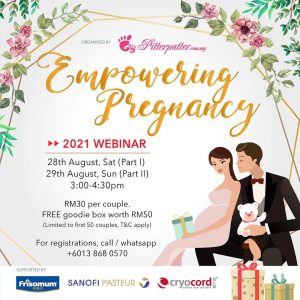
What is induction of labour?
Induction of labour is when the labour process was started artificially though medical intervention or other methods.
What are the reasons for induction of labour?
Most women have a normal pregnancy and normal delivery. However, sometimes induction of labour is indicated in certain conditions whereby your obstetrician feels that it is more risky for the baby to remain inside your womb than to be born.
Common reasons for inducing labour include:
- When your pregnancy is complicated by medical conditions such as hypertension, pre-eclampsia, gestational diabetes and etc
- When your baby is at risk of not getting enough nutrition and oxygen from the placenta and the baby was found to be small
- Your pregnancy has gone beyond 42 weeks (known as a prolonged pregnancy)
- If your water bag broke but labour has not started on its own after 24 hours.
- If there is an infection inside your womb which may endanger you and your baby.
What are the methods to induce labour?
(1) Medications:
Prostaglandin: Prostaglandin E 2 or Prostin, which is available in the form of tablet, pessary or gel, are inserted into the vagina to help to initiate contractions and make the cervix (neck of the womb) softer and thinner. This is usually done in the morning. Your cervix should be re-examined after 6 hours. Your baby’s heartbeat should be checked again when contractions starts.
The advantage of this method is that you can still freely walk about after 1 hour from the insertion of the tablet. By moving about frequently, your baby’s head can help to stretch the cervix and this will further enhance the effect of the Prostaglandin.
Oxytocin: Sometimes you obstetrician may give you this hormone through intravenous infusion at low dose to stimulate contractions. However, this is usually done so when your cervix is already soft and thin.
The advantage of this method is that the amount of hormone which is infused can be controlled easily. If you have already had some mild contractions, oxytocin can speed up the pace of labour. However, by infusing the hormone through a drip, your movement may be restricted.
(2) Artificial Rupture of the Membranes (ARM) or Amniotomy
When your obstetrician breaks your water bag, it will help to produce local release of prostaglandins which helps to initiate uterine contractions. This is usually done when your obstetrician feels that your cervix (the neck of the womb) is soft and stretchy and the likelihood of kick starting your labour is good. The procedure is done using a thin sterile plastic hook which makes a small nick on the water bag just inside the cervix. Your baby will not be harmed by this procedure. As the water bag breaks and the amniotic fluid drains through the vagina, the baby’s head will moves down against the cervix, which helps to strengthen the contractions.
Studies has shown that artificial ruptured of membrane in combination with the use of oxytocin result in fewer women being undelivered vaginally at 24 hours than artificial ruptured of membrane alone. This combination may also shortened the duration of labour by an hour. Artificial rupture of membrane also allows examination of the amniotic fluid for meconium, which may be associated with fetal distress. By rupturing the water bag, a probe for monitoring the baby’s heart rate can be placed directly onto the baby’s scalp.
(3) Natural methods
Breast stimulation has been quoted as a natural form of labour induction which can be done manually or with an electric breastfeeding pump. This will stimulate release of oxytocin hormone which can cause contractions. Studies has shown that comparing breast stimulation with no intervention, there is a significant reduction in the number of women not in labour at 72 hours in the group women who performed breast stimulations. However, it is important to note that nipple stimulation in late pregnancy may cause uterus to contract rigorously and cause profound changes to baby’s heart rate in high risk women. Therefore, you should discuss with your obstetrician if you wish to consider this method of induction.
There has been some interest looking into sexual intercourse in late pregnancy as a method of induction of labour. However, there is not enough evidence to show whether sexual intercourse is effective in hastening the ripening of the cervix and induce labour. However, most study has shown that sexual intercourse at term is not associated with ripening of the cervix and does not hasten labour.
References:
1. Induction of Labour. NICE guideline 70, July 2008
2. Bricker L, Luckas M. Amniotomy alone for induction of labour. Cochrane Database Syst Rev. 2000; (4): CD002862
3. Howarth GR, Botha DJ. Amniotomy plus intravenous oxytocin for induction of labour. Cochrane Database Syst Rev. 2001; (3): CD003250
4. Wei S, Wo BL, Xu H et al. Early amniotomy and early oxytocin for prevention of, or therapy for, delay in first stage spontaneous labour compared with routine care. Cochrane Database Syst Rev. 2009; (2): CD006794.
5. Viegas OA, Arulkumaran S, Gibb DM. Nipple stimulation in late pregnancy causing uterine hyperstimulation and profound fetal bradycardia. Br J Obstet Gynecol. 1984; 91(4): 364-6.
6. Viegas OA, Arulkumaran S. Does coitus embarrass the fetus? Lancet. 1984; 1 (8384): 1015.
7. Kavanagh J, Kelly AJ, Thomas J. Sexual intercourse for cervical ripening and of labour. Cochrane Database Syst Rev. 2001;(2): CD003093.
8. Kavanagh J, Kelly AJ, Thomas J. Breast stimulation for cervical ripening and induction of labour. Cochrane Database Syst Rev. 2001; (4): CD003392.
Filed under Induction of Labour | No Comments








